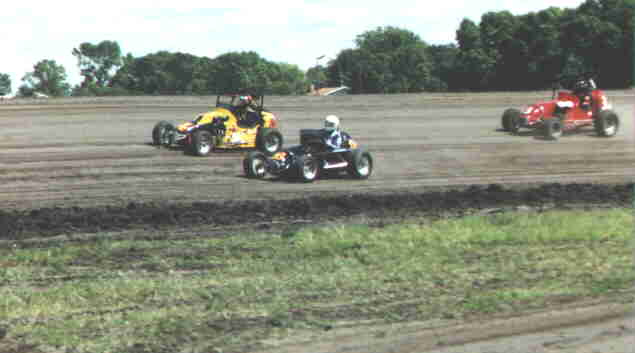
by Don Stauffer

Oval Racing History
Oval racing has a long history. Americans seemed less willing to share public thoroughfares with racing cars, unlike the public in many countries. The wide availability of oval horse racing tracks at so many state and county fairgrounds, however, offered a solution to the problem of where to race early automobiles. The first oval automobile race was held in August of 1896 at the Rhode Island State Fair. In addition to being history's first oval race, it began a long lasting tradition in this country associating auto racing events with state and county fairs.
Oval track racing began at about the same time as professional sports, when promotors found that the public would pay to see sporting events, a situation that offered promotors a chance to make a buck or two. Oval racing soon became a professional sport. While stock car racing on oval tracks goes back to the beginnings of oval track racing (predating NASCAR by a half century), the attention of the public became focused on purpose-built racing cars that offered speed and excitement. These purpose built racing machines, with one notable exception, were basically one-off specials, not mass produced. And, they became obsolete rapidly, soon rusting away into oblivion or being cannibalized for whatever parts still were useful on newer cars.
Vintage Oval Racing
The result was that surviving older racing cars became very rare, and were collected by a few enthusiasts who valued their history, or, for some of the cars with grand winning history, by museums. But the cars were seldom run. The growth of vintage road racing with sports cars led owners and collectors of vintage oval track cars to think about running their precious vehicles. However, since the chassis,and in many cases the engines, were never mass produced, replacement parts were exceedingly rare, and the owners were reluctant to actually compete with the cars. A compromise ensued, where exhibition meets were organized.
In such exhibition meets, the meet was run as if it were a normal race meet, on the some of the many existing dirt race tracks in the country. However, speeds were kept down for the safety of both the drivers and vehicles. Many of these older cars did not even have roll bars, let alone roll cages. Also, open wheel race cars have a vicious tendency to flip and roll if wheels of two cars happen to touch at racing speeds. In exhibition racing a gentlemanly agreement allows everyone in each heat to "lead" for a lap.
 |
 |
While vintage oval racing got started primarily with open wheel racing cars, the clubs involved soon added vintage oval rack stock cars to their membership and events. Cars involved today in vintage oval racing include big cars (sprint cars), championship cars, midgets, three-quarter midgets, and older stock cars such as roadsters, modified coupes and older "late model" cars.
Various clubs have differing age requirements, but typically the cars must be twenty to twenty-five years old. Since many old oval track race cars were fabricated by their owners from stock components, many of the clubs allow modern "reconstructions" of cars fabricated from components of the proper age.
Clubs involved in vintage oval racing include-
ANTIQUE AUTO RACING ASSOCIATION, INC., PO Box 486 Fairview, NC 28730
ATLANTIC COAST OLD TIMERS AUTO RACING CLUB, PO Box 3067 Alexandria, VA 22302
Museums with Vintage oval racers and oval racing history-
Other interesting oval racing history sites;